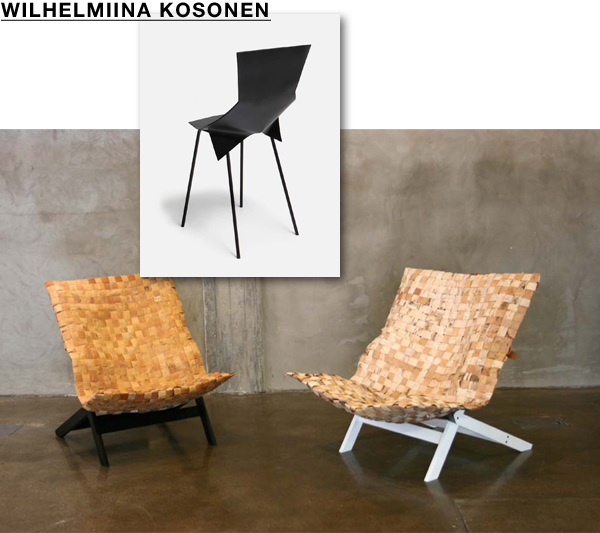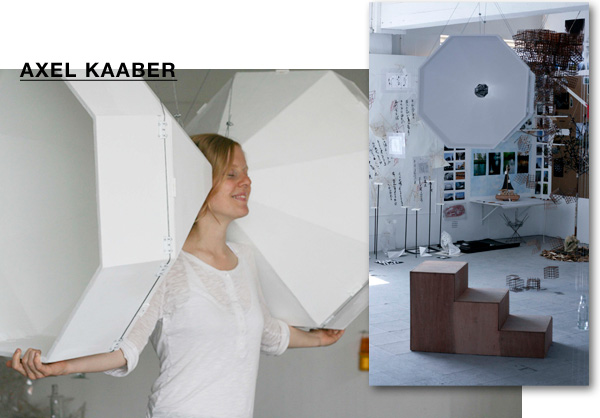
In the 1950s and 1960s Scandinavian design, coming above all from Denmark, Sweden and Finland, came to international prominence. Arne Jacobsen, Carl Malmsten and Alvar Aalto coined a style characterized by minimalism, high-quality materials and solid workmanship. And although during the subsequent decades Scandinavian design took a temporary step back from the international stage, it still retains its significance today. Juliane Grützner asked students from Denmark, Sweden, Norway, Finland and Iceland about Scandinavian design, the soundness of its workmanship and the influence of traditional design virtues on the development of new ideas and designs. Juliane Grützner: Is Scandinavian design always about solid workmanship? Lina Johansson: Always viewing their own works as one-offs seems to be a distinguishing characteristic of Scandinavian designers. They probably hope that maybe someday they will create a great "masterpiece". Moreover, Scandinavian countries have this tradition of transferring the values associated with carefully crafted products to mass-produced items. Many Scandinavian designers put a lot of time and effort into considering materials and technologies. This is a good way to become familiar with production processes and in turn channel these experiences into the design process itself. Ellen Dynebrink: I don't think Scandinavian design always has to be solid but we Scandinavians do appreciate products that have been finished to a high standard. Ǻsmund Wivestad Engesland: I also sense a good feel for materials in Scandinavian design – how one recognizes the various qualities they offer and how to use them. The consistent use of only those things that are absolutely necessary for a particular design is something else that is of great importance here in the Nordic countries. Wilhelmiina Kosonen: For me, Scandinavian design is very strong conceptually. That it is made from high-quality materials goes without saying. Until now the demand for quality in Finnish design has always been answered with aesthetic minimalism. But this appears to be changing, slowly. I'm always delighted by work produced by young Finnish designers who understand how to combine quality with playful elements. Sanelma Hihnala: Solid workmanship plays a huge part in Scandinavian design. In my opinion, it could go even further in this direction. In the future it could be a smart move for designers to place an even greater focus on quality and local craftsmanship rather than quantity and media impact. Bjarke Frederiksen: From the perspective of a carpenter and designer trained and working in Denmark, I am not keen to describe Scandinavian design exclusively in terms of its solid workmanship. It is much more than that. Good craftwork is not something typical to Denmark or Scandinavia; it is a trademark, a label, which a number of designers and manufacturers still like to use. For me personally, craft skills open up so many possibilities that I would not have otherwise. Sometimes I'm astonished at some of my fellow students whose only contact with their own designs is via computer. Erika Ahola: Although Scandinavian design has been industrialized to a high degree, many of the production stages still require technical knowledge, primarily thanks to the frequent use of wood. I don't think that craftwork in itself constitutes a criterion for Scandinavian design; it is rather a question of maintaining the heritage of Scandinavian craftsmanship. Axel Kaaber: Scandinavian design can be anything. This relationship with the classics is useful but you can't allow it to become restrictive. My recommendation: design what you feel, regardless of where you come from. When you work on a design, do you look back at past traditions or forward to the future to invent something new? Johansson: If you want to design something new, you have to first look back to the respective design heritage and the object's roots. It's important to know where you're coming from in order to develop and move forward. I use my knowledge of traditions within textile design as a tool in the design process. This can lead to combinations of old techniques and new materials or the discovery of a new function for something that has already been around for a long time. Frederiksen: I find it really interesting to establish a connection between invention and design. The idea of designing a chair goes way back in design history, while the idea of designing something new temporarily suspends the traditional understanding of form and function. This leads you to suddenly see the chair as a catalyst for new social ideas and concepts. It is then the designer's task to place these ideas into a design context, making them accessible to the wider public. Otherwise they just wander free, in a similar way to art. I consider my own way of designing as a continuous process, during which I constantly listen to my intuition, which itself is the product of all of those things that I perceive. The way I perceive things has of course been influenced by my training as a carpenter. If I look back to past traditions when creating a design, I most definitely try to integrate a new element into the design process, too; an element that may challenge the notion and prevent it from remaining just a handcrafted piece. How important is sustainability for you as an aspect of design? Kosonen: The state of the environment influences all our living conditions and for that reason we have to take it into consideration in everything that we do. Sustainability represents a great challenge for us all, but we as designers are extremely lucky in that we have an influence over the design process and are able to choose materials such that you end up with the most practical, most environmentally-friendly solution. Dynebrink: That is really important. However, I myself find it very difficult to think about the effects sustainability could have on the production, use and afterlife of a product at such an early stage as the design process. Hihnala: Sustainability is always at the back of my mind. I prefer to design something for a specific location or for a specific purpose, that way I am in a better position to assess the lifecycle of a product. I'm not interested in mass production but in durable, environmentally-friendly design made from high-quality local materials. Ahola: Sustainability constitutes a fundamental link in the design-process chain. Selecting the right materials, production processes and packaging does after all have a significant effect on the end product. Our focus now, as before, is on designing an accomplished product. Only those products that are a success in their time can in fact be deemed ecological. Kaaber: In my field, architecture, sustainability is always an important aspect. I prefer projects that source their materials locally and incorporate sustainability as an integral part of the design. When you are working on a design, do you consider the material or the function first? Kosonen: A strong concept or a story often forms the starting point for my projects. Sometimes a certain material inspires me to create a design, as was the case with the "BBKING Chair", for which I used birch bark. This material's place in Finland's cultural tradition presented me with the challenge of finding a contemporary use for it within furniture design. Hihnala: For me, these two elements go hand in hand. Of course, there has to be a good reason behind the decision to use a certain material. And this reason also determines its function. I like to work with wood and I like to do so in such a way that it maintains its natural character. And that is what makes a product unique. Ahola: The material and function of an item of furniture are two inseparable elements. For me, designing furniture means always finding the best combination of material and function, something that functions as a whole. Materials have to correspond to an item of furniture in terms of both structure and aesthetics in order to create an accomplished design. Does design have a social function? Frederiksen: I don't believe that design needs a social function forced upon it. But if a designer has a particularly critical or ideologically-motivated approach, of course they can demonstrate that by means of their design. Who are your role models within design? Engesland: I admire the works of great designers and architects such as Walter Gropius, Alvar Aalto, Mies van der Rohe, Børge Mogensen, Erling Viksjø and Yngve Ekström, the founder of Swedese. They all represent an approach that I find simply inspiring: They take on projects with minimal funding and succeeded in creating priceless, unmistakable works. What kind of status does textile design have in comparison to other design disciplines? Johansson: Textile design hides a great deal of untapped potential. The materials and techniques available in this field offer infinite possibilities in terms of design. Designers who themselves do not work with textiles don't have any idea of the things that you can do with them. Those who only work within one discipline are really restricting themselves. It is only when designers from different fields work together that they can learn from one another. I hope that textile design sees an increase in prominence and conquers new territories. What do you want to do after graduating? Kaaber: After finishing my degree I would first of all like to go abroad to learn about other areas in both an academic and a practical sense. After that I'd like to return to Iceland and put everything I've learned into practice. I think having a range of designers with different experiences in one place represents a true enrichment for the design scene. Engesland: After graduation I would like to work in a small office community that brings together people from different design disciplines. I believe that a varied range of jobs generates good projects. Moreover, at the first given opportunity I would like to establish a platform where designers can meet, organize exhibitions and challenge one another. The students interviewed were: Ellen Dynebrink, 25, and Lina Johansson, 26, from The Swedish School of Textiles, University of Borås; Ǻsmund Wivestad Engesland, 27, from Kunsthøgskolen Oslo – Oslo National Academy of the Arts; Erika Ahola, 29, Sanelma Hihnala, 28, and Wilhelmiina Kosonen, 30, from Aalto University, School of Art, Design and Architecture, Helsinki; Bjarke Frederiksen, 32, The Royal Danish Academy of Fine Arts, School of Design, Copenhagen and Axel Kaaber, 27, Iceland Academy of the Arts – Architecture department, Reykjavik.
















